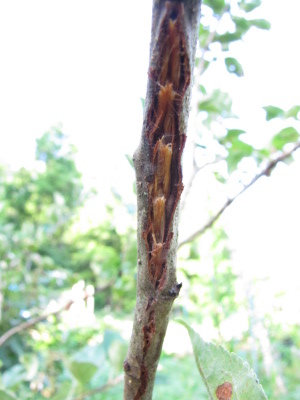
Planning around cicadas in the orchard
 I learned my next lesson on timing the hard
way. In 2012, periodic cicadas crawled out of the ground and
regaled us with their ocean-like symphony. I was intrigued by the
natural occurrence and enjoyed feeding these protein-rich insects to our
chickens, so at first I thought the periodic cicadas were a boon to our
farm. Then I saw this the damage pictured to the left.
I learned my next lesson on timing the hard
way. In 2012, periodic cicadas crawled out of the ground and
regaled us with their ocean-like symphony. I was intrigued by the
natural occurrence and enjoyed feeding these protein-rich insects to our
chickens, so at first I thought the periodic cicadas were a boon to our
farm. Then I saw this the damage pictured to the left.
It turns out that cicadas lay their eggs in tender
twigs of young trees, and seem to preferentially choose fruiting species
over wild saplings. When the young cicadas hatch from their twig
homes, the nymphs drop to the ground and tunnel down to feed on the
tree's roots. While the root sucking may be a long-term problem,
the real issue is that the nymphs damage fruit-tree twigs so much while
coming out of their eggs that the branches often break off and die.
 scarce. Every 13 to 17 years, the periodic
cicadas come out of the ground and provide a feast, but by then, the predator
levels are so low that the majority of the cicadas survive untouched. That's why
we have to get a bit more wily when dealing with these insects—periodic
cicadas have outwitted their natural enemies and we can't count on help
from nature.
scarce. Every 13 to 17 years, the periodic
cicadas come out of the ground and provide a feast, but by then, the predator
levels are so low that the majority of the cicadas survive untouched. That's why
we have to get a bit more wily when dealing with these insects—periodic
cicadas have outwitted their natural enemies and we can't count on help
from nature.
The short-term solution to cicada damage is to net
adult cicadas away from the twigs as soon as you hear periodic cicadas
calling. But smarter orchardists also plan around cicada
cycles. If you go to
http://hydrodictyon.eeb.uconn.edu/projects/cicada/databases/magicicada/magi_search.php,
you can choose your state and county and then find out when periodic
cicadas have emerged in your region recently. Add the appropriate
number of years to those emergence dates and you'll know when the next
brood will be out looking for baby fruit trees.
In a perfect world, you'd plant fruit trees no more
than two years before cicada-emergence dates since cicadas aren't as
interested in older trees. Orchardists also choose not to winter
prune fruit trees during a year when periodic cicadas are due to emerge,
knowing the cicadas will do some of their pruning for them.
That's true permaculture gardening at work!
I hope you enjoyed this excerpt from Naturally Bug-Free!
If so, you can download the ebook for $1.99 on Amazon by clicking the
link above. Or just wait for another excerpt tomorrow on the blog.
| This post is part of our Naturally Bug-Free lunchtime series.
Read all of the entries: |
Want more in-depth information? Browse through our books.
Or explore more posts by date or by subject.
About us: Anna Hess and Mark Hamilton spent over a decade living self-sufficiently in the mountains of Virginia before moving north to start over from scratch in the foothills of Ohio. They've experimented with permaculture, no-till gardening, trailersteading, home-based microbusinesses and much more, writing about their adventures in both blogs and books.
Want to be notified when new comments are posted on this page? Click on the RSS button after you add a comment to subscribe to the comment feed, or simply check the box beside "email replies to me" while writing your comment.

Hi Anna - your comment about feeding the cicadas to the chickens made me wonder if you also bring the piles of winter-killed bees from your hives to your hens?
Thanks!